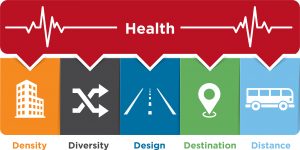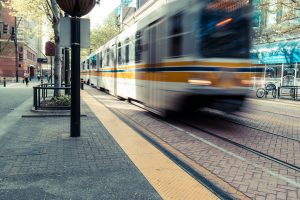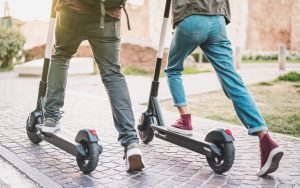Walk around any downtown, and you will observe how the infrastructure has (or has not) encouraged people to choose travel modes other than the personal automobile. The operative word in the previous sentence is walk, of course. Along with bicycling, walking is one of the “active modes” of travel with a connection to individual health outcomes.
The connection between health and transportation is well documented, but only recently has the topic gained significant attention among transportation planning practitioners, many of whom have started to consider it as part of the planning process. With support from officials at various levels of government, more practitioners are looking for ways to repurpose existing planning tools and datasets to document the health impacts of planning decisions.
For RSG’s Theodore Mansfield, PhD, this renewed focus on transportation’s role in health outcomes comes as welcome news. Ted earned his doctorate from the Gillings School of Global Public Health at the University of North Carolina at Chapel Hill. While there, he explored the nexus between transportation and health. In his dissertation, he developed novel multirisk frameworks to estimate the competing health impacts of transportation in the Raleigh area. Specifically, his work examined how transportation health risks from mobile-source emissions (vehicles), physical inactivity, and fatal crashes varied across different types of neighborhoods in the region.
After completing his doctoral studies, Ted spent several years in the Office of the Secretary of Transportation. While there, he developed a tool to help transportation planners across the country better understand pedestrian safety in their communities.
Now, in his role as a Senior Consultant at RSG, Ted is applying his knowledge to develop health-oriented planning tools and solutions for clients. Ted is one of the primary contributors to RSG’s forthcoming white paper on strategies for integrating health outcomes into the transportation planning process. He is also scheduled to present on this topic alongside other RSGers during the 2023 Transportation Research Board Annual Meeting in Washington, DC, in January.
We connected with Ted to talk about health, transportation, and how the intersection between these two fields is reshaping the tools and data used by practitioners.
How does the built environment shape individual travel behavior choices, and how does this affect health outcomes?
A popular way to think about the interaction between health and transportation planning is through the five Ds: the density of population and employment, diversity of land use, physical design, destination accessibility, and distance to transit.

The five Ds of health and transportation planning: density of population and employment, diversity of land use, physical design, destination accessibility, and distance to transit. Source: RSG
If we consider the first two Ds (density and land use diversity), people and places will be closer to each other with higher-density, mixed-use developments. This influences how people travel and what travel mode they use. If attractions are nearby, more people may choose active travel modes such as bicycling and walking. This is contingent, of course, on the built environment providing a safe and comfortable environment for pedestrians and bicycles to support these transportation choices.
Public transportation helps support healthy communities, as well. After all, many public transportation trips begin or end with a walk or bike trip. Public transportation systems can also help encourage denser land development that supports walking and bicycling—for transit system users and nonusers alike. Finally, a wide range of transportation demand management policies—things like road pricing and parking regulations—shape transportation choices.
Of course, individuals’ preferences play a role here as well. But the built environment can help make choices that support improved health outcomes easier. Importantly, the decisions that transportation and city planners make can help shape the built environment. That part is important to remember—while the built environment appears fixed, it is modifiable. Simple changes can help people make certain travel choices easier. Put simply, the small actions of transportation planners help shape risks through the systems we build.
How are federal and state decision-makers addressing this issue and proactively integrating equity into their decision-making toolkit?
At the federal level, we have seen some important actions to tilt the built environment toward positive health outcomes. The Bipartisan Infrastructure Law, enacted in 2021, included the Reconnecting Communities Pilot (RCP) program. This discretionary grant program will deliver $1 billion in funding over 5 years. The money will help to reconnect communities cut off from opportunity by transportation infrastructure.
Critically, the US Department of Transportation (USDOT) has also recently updated guidance for performing benefit-cost analysis (BCA) for discretionary grant programs to include health benefits. This guidance essentially extends health considerations into all discretionary programs administered by USDOT, such as the Rebuilding American Infrastructure with Sustainability and Equity (RAISE) program.
The RCP and the inclusion of health benefits in USDOT’s BCA guidance illustrate the shift in thinking underway now. This new way of thinking recognizes the harm and deleterious health impacts of past transportation planning decisions. Importantly, it provides resources for communities to address them. This is encouraging to see at the federal level.

Also at the federal level, the USDOT has made equity one of its strategic goals and a core tenet of its strategic plan. USDOT’s strategic plan is an important document as it is what the administration uses to plan transportation priorities. The plan mentions health several times in the context of adverse health and safety outcomes, especially among vulnerable populations.
At the state level, Rhode Island and California have both included health objectives in their most recent statewide transportation plans, and the Minnesota Department of Transportation has established an Office of Sustainability and Public Health to coordinate activities related to sustainability and public health within the department.
What strategies can our clients consider as they look to repurpose or retool existing resources to answer health-related questions? What are the projects that RSG has worked on with clients that demonstrate this type of work?
Many of our clients have expressed a desire to begin considering health as part of their planning process. The good news is that there is a wealth of data, tools, and models to support this. As practitioners, we have found that sometimes we can repurpose existing tools to support health considerations. Other times, we may be able to rethink how we use transportation data to support health goals. Finally, we can build new tools when our existing models fall short.
At RSG, we specialize in building travel demand models. These models help transportation planners make decisions about the future of their communities—and these decisions have public health impacts. Integrating travel demand models with health impact models can help connect the dots.
An example of this is from a project RSG worked on in Raleigh, North Carolina. Our team integrated a custom health impact assessment tool with the region’s four-step travel demand model. This allowed the regional planning agency to include health performance metrics in a recent strategic planning effort. These health performance metrics also helped in public meetings to aid community choices.
On the topic of data, household travel survey data can provide insight into the connections between health and transportation. Regional planning agencies collect such data routinely and use it to support a wide range of transportation decisions. These data, especially those coming from high-quality location-aware market research apps like rMove™, can help planners understand the transportation choices that people are making and how the built environment is influencing these choices.

A great example of this type of application was seen in the Twin Cities. Our team used rMove to provide additional insights into how the built environment shapes travel behavior and choices. Some of the questions we explored went back to the five-D variables mentioned earlier.
Using smartphone trace data, we were also able to understand potential barrier effects of roadways in regions. For example, we saw people who travel near major freeways were less likely to walk/bike. This was the topic of the Transportation Research Board paper that was accepted for presentation in January 2023 and that we coauthored with our client at Metropolitan Council.
While existing models and data may work in many cases, our clients may also find that they need to build new tools. This was the case for a project our team worked on in the Salt Lake City region. In this instance, we constructed an entirely new bike travel demand model. Using the model, our client could better understand how to prioritize investment in their transportation infrastructure.
What other changes would you like to see made to policies and guidance? How would these changes better integrate health into the transportation planning process?
Recent federal actions excite professionals in this space who are concerned with the health impacts of transportation decisions. The work done to date at the federal level is a great start and energizing to practitioners.
If I were to think of three things USDOT could do to further capitalize on this enthusiasm and energy, I would focus on including health considerations in discretionary grant programs, empowering metropolitan planning organizations (MPOs) to consider health, and establishing pilot programs.
Discretionary grant programs, such as RAISE, could include direct references to health and equity in their Notices of Funding Opportunity (NOFOs). That would be transformative.
Much of the planning process happens at the MPO level, and many MPOs are innovating in this area. The federal government could facilitate this work and host peer exchanges in their role as conveners of experts in the field. This could also mean providing research dollars via university transportation research centers focused on this connection.

Pilot programs are also a great way to build momentum. When I worked at USDOT, I was heavily involved in the Safety Data Initiative. This initiative included a pilot program, which started out with three small research projects. After the success of these research projects—for example, the project I led was published in a top journal—USDOT administered a grant program to create new safety tools, based on the initiative’s research projects, to promote safety at the state and local levels. The federal government was seen as a leader as a result. USDOT could create a program on health equity that looks similar to this.
What are some additional considerations for state or local agencies looking to start collecting health-related data? What tools or methods (existing or new) would best serve them and their constituencies?
Anyone looking to start collecting health data should consider fostering partnerships at the local level. Groups already exist that are thinking about this issue in communities. However, such groups may not be traditional partners for transportation agencies. These partnerships can help transportation agencies better understand how the transportation system may be impacting the health of their communities. This could also help unlock additional funding mechanisms for efforts to improve community health through transportation improvements.
Partnerships can also help transportation agencies communicate health connections to stakeholders. Public health language is nuanced and effective communication with stakeholders is critical. Partnerships can help transportation agencies use appropriate language.
You recently gave a presentation on this topic to a group of students as part of a UC Berkeley Institute of Transportation Studies seminar series. What takeaways did you leave with after your presentation?
It was an honor to share my work during the seminar and speak to future leaders in the field. Equity emerged as an important topic on the mind of attendees—and for good reason. Equity is a bedrock principle of public health. Inequities in the health status of groups in the United States and across the world signal the need to act.
Another takeaway was that we (meaning practitioners in the field) cannot wait for the perfect tool or evidence before we act. Just as we are comfortable using travel demand models—which are imperfect—we should also be comfortable using imperfect models that examine the connections between health and the built environment.
For me, a strong pragmatic argument for action exists here based on the need to address historical inequities. We cannot let perfect be the enemy of good in this case. In practice, this means potentially acknowledging the uncertainty in all the models we use—and being okay with that. We need to embrace uncertainty to move forward.
My biggest takeaway from the seminar? A ton of energy and passion can be seen among those joining our profession. Luckily for them and everyone else, we can now build the tools we need or repurpose the tools we have.
······························
Theodore Mansfield, PhD, is a transportation data scientist interested in building custom software tools to estimate the health and equity impacts of transportation systems, integrating health considerations into prevailing transportation planning tools, and leveraging new data sources to better understand travel behavior. Ted’s focus is on understanding the equity implications and health impacts of transportation systems. He is a member of the Transportation Research Board’s Transportation and Public Health Committee and Urban Transportation Data and Information Systems Committee.



